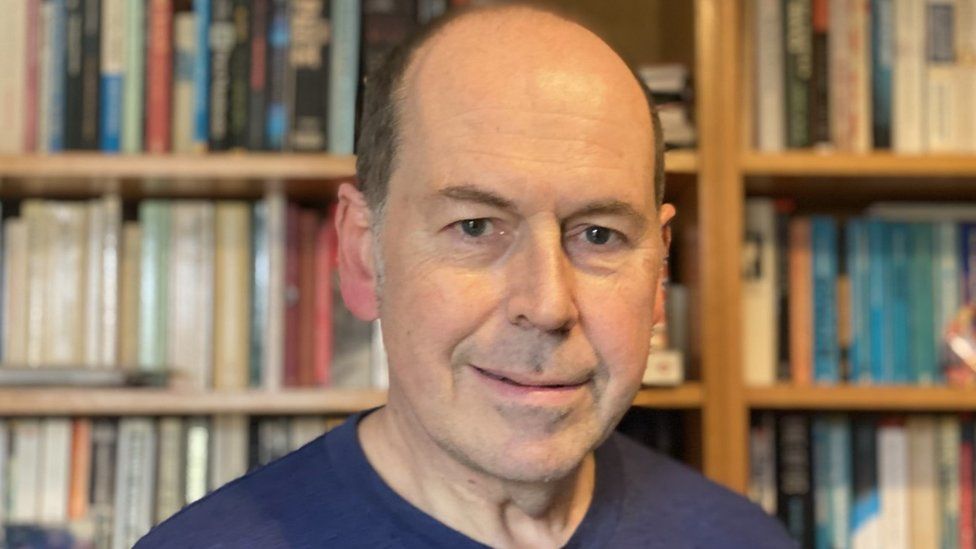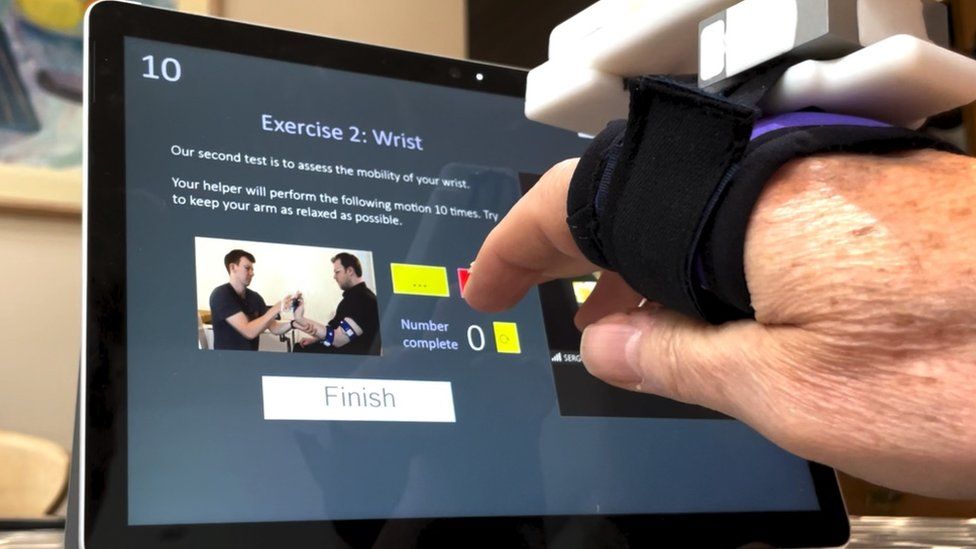
For two weeks recently I got into a steady routine. At 10:30 each morning, I would sit at my kitchen table, strap three devices containing sensors to my right arm, and switch on a tablet computer. Then I would spend 20 minutes going through a series of exercises monitored by a man who popped up in a window on the screen.
The results of my endeavours will, I hope, help millions of people like me dealing with Parkinson's disease.
My daily routine was part of a medical trial run by engineers from Imperial College and a start-up company they have founded, in collaboration with a consultant neurologist at London's Charing Cross Hospital. Its aim - to use artificial intelligence techniques to develop a wearable device that could monitor the symptoms of Parkinson's disease and even perhaps help to treat it.
For me that is an exciting prospect. I was diagnosed with Parkinson's in January 2019 and the first thing I was told was that there is no cure for this disease which afflicts something like 10 million people and is the world's fastest growing neurological condition.
'Notoriously difficult'
There is medication to treat the symptoms but it is notoriously difficult to prescribe exactly the right dose of Sinemet and other drugs which act to replace the missing dopamine that makes someone with Parkinson's shake or drag their foot. In my case, it was not clear to me that the drugs were working.
That is how I ended up being sent by my own consultant at St Mary's Hospital Paddington for a second opinion from Dr Yen Tai, the neurologist at Charing Cross working with Imperial College. After he had prescribed me a new drug, we got talking about technology and how it might help in the battle against Parkinson's. When he offered to enrol me in the Imperial trial, I leaped at the chance.

The exercises I did each morning - twisting my hand from side to side, holding it out in front of me, moving my arm up and down - were similar to what my consultant makes me do on my visits every four months. The idea is that the data recorded by the sensors and the video of the session will gradually teach the AI system how to grade symptoms in the way a human doctor does.
Neurologists use what's called the UPDRS - the Unified Parkinson's Disease Rating Score - to calibrate the severity of a patient's symptoms. Earlier in the trial, other patients of Dr Tai had been assessed by him at his clinic, and his UPDRS ratings were then fed into the AI system as part of its learning data.
Ravi Vaidyanathan, reader in biomechanics at Imperial College and principal investigator for this research programme, laughed when I said the aim seemed to be to take Dr Tai's brain and put it in the AI. "We are a few light years from being able to take what Yen's brain can do," he said." But we are trying to take his diagnostic capacity into the automated system. And that's how machine learning works."
The Imperial team is not alone in exploring how wearable devices could be used to diagnose and monitor Parkinson's. "Wearable sensors are quite a popular hot topic in Parkinson's research for a number of years now," says Dr Tai. A team at Apple, working with medical specialists, showed how the Apple Watch could be used to monitor symptoms and measure their response to medication.
But the Imperial team believes their trial goes further than any other in collecting data about all of the main Parkinson's symptoms - stiffness of the limbs, tremor and slowness of movement.
What is exciting is what comes next. Later this year, SERG Technologies, the spinout from Imperial working to commercialise this research, hopes to have something much less clunky - "a nice, lean simple device," says Ravi Vaidyanathan.

'Tailored treatment'
"At first this could be used once more to put patients through various exercises to assess their symptoms but later the idea is that it could just collect data as people went about their daily lives.
"So when you just pick up a cup of coffee, when you pick up a pencil, when you pick up a pen, we would have something that you could wear unobtrusively all day that would keep recording what you are doing."
Coupled with data about when a patient takes their medicine, the smart device could then provide continuous monitoring of how a patient responded. "Hopefully this will provide a more personalised, more tailored treatment to an individual patient," says Dr Tai.
Further ahead, the wearable device could actually provide treatment. A new project supported by a £1m grant from the National Institute of Health Research, will explore shooting tiny amounts of current into the patient's muscle to control tremors.
For all the work being done here and around the world to improve the monitoring and treatment of Parkinson's, there is still no cure on the horizon.
"Ultimately we still need to have something that can slow down the brain degeneration process," Dr Tai says. "But it doesn't mean we can't optimise treatment at the same time while we are trying to find a cure for Parkinson's."
I hope to continue on this journey seeking a better understanding and improved treatment of Parkinson's. I will report back on any progress.
"how" - Google News
June 04, 2021 at 07:42AM
https://ift.tt/3cfAWkH
How AI is working with Parkinson’s patients? - BBC News
"how" - Google News
https://ift.tt/2MfXd3I
Bagikan Berita Ini














0 Response to "How AI is working with Parkinson’s patients? - BBC News"
Post a Comment